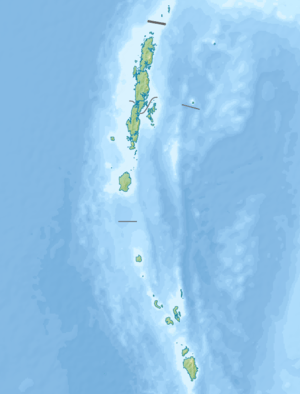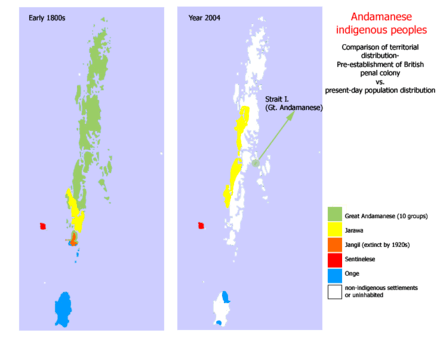Sentinelese
| Total population | |
|---|---|
| 15[1]–500[2] | |
| Regions with significant populations | |
| North Sentinel Island | |
| Languages | |
| Sentinelese | |
| Related ethnic groups | |
| Perhaps Jarawa or Onge | |
 North Sentinel Island North Sentinel Island (India)  North Sentinel Island North Sentinel Island (Andaman and Nicobar Islands) |
The Sentinelese (also called the Sentineli or North Sentinel Islanders) are the indigenous people of North Sentinel Island in the Andaman Islands of India. One of the Andamanese people, they resist contact with the outside world. They are one of the uncontacted peoples, although like all of today’s so-called uncontacted people they have a history of limited contact.[3]

(a) Rapid depopulation of the original southeastern Jarawa homeland in the 1789–1793 period
(b) Onge (in blue) and Great Andamanese shrinkage to isolated settlements
(c) Complete Jangil extinction by 1931
(d) Jarawa move to occupy depopulated former west coast homeland of the Great Andamanese, and
(e) Only the Sentinelese zone is somewhat intact
The population is estimated at 40 to 500. In 2001, Census of India officials recorded[4] 21 males and 18 females. This survey was conducted from a distance and may not be accurate for the population which ranges over the 59.67 km2 (14,700 acres) island.[5] The 2011 Census of India recorded 12 males and three females.[1] Any effect from the 2004 Indian Ocean earthquake and resulting tsunami is not known, other than the confirmation obtained that they had survived the immediate aftermath.[6]
Author Heinrich Harrer described one man as being 1.6 metres (5 ft 3 in) tall and apparently left handed.[7]
Culture
The Sentinelese are a hunter-gatherer society subsisting on hunting, fishing, and collecting wild plants. There is no evidence of agriculture or fire making.[8] The Sentinelese language is an unclassified language and is not mutually intelligible with the Jarawa language of their nearest neighbors.[4] The Sentinelese are designated as a Scheduled Tribe.[9]
Advanced metalwork appears to be unknown. It has been observed, however, that they have made adroit use of metal objects which have washed up or been left behind on their shores, having some ability at cold smithing and sharpening iron and incorporating it into weapons and other items. For example, in the late 1980s two international container ships ran aground on the island's external coral reefs; the Sentinelese retrieved several items of iron from the vessels.[10]
The 1880 British expedition to the island led by Maurice Vidal Portman reported that "their methods of cooking and preparing their food resemble those of the Öngés, not those of the aborigines of the Great Andaman."[11]
Incidents of contact
In January 1880, an armed British expedition to the island led by 20-year-old Maurice Vidal Portman, the local colonial administrator, arrived to conduct a survey of the island, and to take a prisoner, in accordance with British policy regarding unwelcoming tribes at the time, which was to kidnap a member of the tribe, treat them well and give them gifts, and release them back to the tribe, hoping to demonstrate friendliness. Portman's expedition of the island is believed to be the first by outsiders. While the Sentinelese tended to disappear into the jungle whenever outsiders were spotted approaching, Portman's expedition found an elderly couple and four children after several days. They were taken prisoner and brought to Port Blair. The adults died, possibly from contracting diseases to which they did not have immunity. The four children were given gifts, and released on the island where they disappeared into the jungle. The British did not subsequently try to contact the Sentinelese and instead focused on other tribes.[12]
In 1967, the Indian government began a series of contact expeditions to the island. The program was managed by the Director of Tribal Welfare and anthropologist Triloknath Pandit. The first expedition, headed by Pandit, included armed police and naval officers. The Sentinelese retreated into the jungle, and the expedition failed to make contact. During these expeditions, an Indian Navy vessel would anchor outside the coral reefs and send small boats to approach the beaches, and while keeping a distance, the crew would drop various gifts into the water to wash up on shore. If the Sentinelese fled for the jungle, the parties might land on shore and drop off the gifts before leaving.[12]
In early 1974, a National Geographic film crew went to the island with a team of anthropologists filming a documentary, Man in Search of Man. The team was accompanied by armed police officers. When the motorboat broke through the barrier reefs, locals emerged from the jungle and shot arrows at the boat. The boat landed at a point on the coast out of range of the arrows and the police (dressed in jackets with padded armour) landed and left gifts in the sand: a miniature plastic car, some coconuts, a live pig tied, a doll, and aluminium cookware.[13] The locals' reaction was to launch another round of arrows, one of which struck the documentary's director in the thigh. The man who wounded the director withdrew and laughed proudly, sitting in the shade while others speared, then buried the pig and the doll. Afterwards, they left, taking with them only the coconuts and aluminium cookware.[14]
There were documented occasions (one in 1980) when Onge-speaking individuals were taken to North Sentinel Island to attempt communication, resulting in brief and hostile exchanges, during which they were unable to recognise any of the language spoken by the inhabitants.[15]
In August 1981, the cargo ship Primrose ran aground in rough seas just off North Sentinel Island, stranding a small crew. After a few days, a reported 50 islanders appeared, threatening the crew. The captain of the ship broadcast urgent messages indicating that natives were on the verge of attacking the vessel with arrows and spears.[16] Nearly a week later, the ship was evacuated by helicopter.
In the early 1990s, the Sentinelese began allowing boats to approach the shore, sometimes greeting passengers unarmed. However, after a few minutes, the Sentinelese would begin to make menacing gestures and to fire arrows without arrowheads. In 1996, the Indian government ended the contact expeditions following a series of hostile encounters resulting in several deaths in a similar program involving the Jarawa people of South and Middle Andaman Islands and because of the danger of introducing diseases.[12]
The Sentinelese appear to have emerged relatively unscathed from the 2004 Indian Ocean tsunami, apparently managing to reach high ground. Three days after the tsunami, an Indian naval helicopter was sent to check on the Sentinelese and to drop food on the beach. The helicopter was threatened by Sentinelese warriors who emerged from the jungle and brandished a bow and arrow.[12]
In 2006, two men were poaching mud crabs near the island. Their boat's improvised anchor failed to prevent it from drifting near the island while they were in a deep, probably drunken, sleep.[17] The men were attacked and killed. An Indian Coast Guard helicopter sent to retrieve the bodies was repelled by a volley of arrows. The Indian government did not try to prosecute the murders, because it considers the Sentinelese a sovereign people, with the right to kill interlopers with impunity.[17]
Notes
- 1 2 District Census Handbook: Andaman & Nicobar Islands (PDF). Census of India (Report). 2011. p. 156. Archived (PDF) from the original on 1 August 2015. Retrieved 1 August 2015.
- ↑ "Earth from Space: North Sentinel Island". European Space Agency. 29 April 2005. Retrieved 1 August 2015.
- ↑ Nuwer, Rachel. "Anthropology: The sad truth about uncontacted tribes". BBC. Retrieved 8 August 2018.
- 1 2 Enumeration of Primitive Tribes in A&N Islands: A Challenge (PDF) (Report). Archived (PDF) from the original on 11 December 2014.
The first batch could identify 31 Sentinelese. The second batch could count altogether 39 Sentinelese consisting of male and female adults, children and infants. During both the contacts the enumeration team tried to communicate with them through some Jarawa words and gestures, but, Sentinelese could not understand those verbal words.
- ↑ http://ls1.and.nic.in/doef/WebPages/ForestStatistics2013.pdf
- ↑ "Did Island Tribes Use Ancient Lore to Evade Tsunami?". National Geographic Society. 24 January 2005. Archived from the original on 12 August 2018. Retrieved 1 December 2014.
- ↑ Harrer, Heinrich (1977). Die letzten Fünfhundert: Expedition zu d. Zwergvölkern auf d. Andamanen [The last five hundred: Expedition to the dwarf peoples in the Andaman Islands] (in German). Berlin: Ullstein. ISBN 3-550-06574-4. OCLC 4133917. Retrieved 26 July 2015.
- ↑ Burman, B. K. Roy, ed. (1990). Cartography for development of outlying states and islands of India: short papers submitted at NATMO Seminar, Calcutta, December 3–6, 1990. National Atlas and Thematic Mapping Organisation, Ministry of Science and Technology, Government of India. p. 203. OCLC 26542161.
- ↑ "List of notified Scheduled Tribes" (PDF). Census India. p. 27. Retrieved 15 December 2013.
- ↑ Master Plan 1991–2021 for Welfare of Primitive Tribes of Andaman and Nicobar Islands, Sec. II Ch. 21. Dept. of Tribal Welfare, Andaman and Nicobar Islands Administration; as reproduced in Andaman Book
- ↑ Portman, Maurice Vidal (1899). "Jàrawas". A History of Our Relations with the Andamanese. II. Calcutta: Office of the Superintendent of Government Printing, India. p. 728. OCLC 861984. Retrieved 26 July 2015.
- 1 2 3 4 "The Forbidden Island". Neatorama. Retrieved 8 August 2018.
- ↑ Pandya, Vishvajit (2009). In the Forest: Visual and Material Worlds of Andamanese History (1858–2006). University Press of America. p. 357. ISBN 978-0-7618-4272-9. OCLC 673383888.
- ↑ "North Sentinel Island: A Glimpse Into Prehistory". YouTube. Retrieved 30 May 2017.
- ↑ Vishvajit Pandya, "In the Forest: Visual and Material Worlds of Andamanese History (1858-2006)," p. 362, (University Press of America, 2008) ISBN 0-7618-4153-9, ISBN 978-0-7618-4153-1, found at Google Books. Accessed 2009-10-07.
- ↑ "Twenty-eight sailors shipwrecked for nearly two weeks off a..." UPI. 25 August 1981. Retrieved 29 May 2017.
- 1 2 Foster, Peter (8 February 2006). "Stone Age tribe kills fishermen who strayed on to island". The Telegraph. Retrieved 25 August 2013.
References
- Pandit, T. N. (1990). The Sentinelese. Kolkata: Seagull Books. ISBN 81-7046-081-6.
- Weber, George (2005). "The Andamanese". The Lonely Islands. The Andaman Association. Archived from the original on June 3, 2013.
External links
- Video of friendly contact with the Sentinelese, YouTube.com
- Video of National Geographic crew's attempt at contact being rebuffed by the Sentinelese, YouTube.com
- Madhumala Chattopadhyay: An Anthropologist’s Moment of Truth – discusses first friendly contact with Sentinelese
- Administration in India's Andaman and Nicobar Islands has finally decided upon a policy of minimal interference
- "The most isolated tribe in the world?". Uncontacted tribes. Survival International.
- McDougall, Dan (11 February 2006). "Survival comes first for the last Stone Age tribe world". The Guardian. Retrieved 1 August 2015.